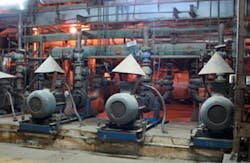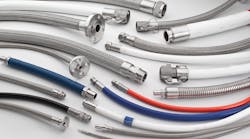Dear Pump Guy,
(a.k.a. "Pump Guy")
I’m a mechanical engineer at a Carolina power company. We design, procure and build fossil-fuel power stations. I recently read and enjoyed your magazine article on back pull-out pumps.
I read that suction pipe velocities should be in the range of 6 to 8 feet per second. Higher velocities increase the friction losses.
If the NPSH criteria are met, what is wrong with higher velocities? Please offer your comments on this.
Regards,
Judson P.
Mechanical & Layout Engineering Supervisor
###
Judson,
To answer your question, “High liquid velocity in a pipe can cause dissolved air in water to separate and form bubbles.”
Let’s consider the liquid:
Some liquids are sensitive to shear. The liquid properties change with shear (agitation or turbulence). Shear is plotted on a stress-strain graph. Temperature is a factor and the liquid’s viscosity is a factor. When conditions are favorable, dissolved gases and other components may separate from the liquid and come out of suspension. I suggest you learn more about shear sensitivity.
Soapy water will foam, froth and form bubbles when the water is agitated. Freshly graduated from university, I moved into an apartment with an automatic dishwasher. I didn’t have any automatic dishwasher detergent, so I used standard dish soap in my dishwasher. WOW!! My kitchen filled with suds. I gained a new respect for “low-foaming” automatic dishwasher detergent. I’m lucky my university diploma didn’t get wet.
At the ocean, the salty seawater tends to foam and froth as the waves break (shear) against the beach. Pumping detergents, hydroxides (NaOH, CaOH, NH4OH), and electrolytes including salts (NaCl, NH4Cl, CaCl) (boiler and water treatment chemicals) is likely to form bubbles with shear in the suction pipe.
Consider liquids with entrained gas:
Certainly everyone has opened a can of soda or beer after it had been dropped and had it spew. Popping the cork on a bottle of champagne will produce the same effect.
Consider liquids pumped at the liquid’s vapor pressure:
You can shake a canister of propane or refrigerant and hear the liquid sloshing inside the container. Yet, when you open the valve and the liquid shears through the exit nozzle, there is only gas. Nothing drips onto the floor. So these gassing liquids are susceptible to change phase with shear and velocity.
Standard cold water has dissolved oxygen in it. This dissolved oxygen is what the fish breathe. The oxygen bubbles form on the bottom of a saucepan when heated on the stove before the actual boiling begins. This is also the reason that DA (deaerator) tanks were invented for boiler feedwater pumps. Turbulence and velocity (shear) cause the oxygen to separate from the feedwater.
The 'Pump Guy' Says:
As for suction pipe leading to a pump, the “Pump Guy” says, “Suction pipe should be as short as possible with minimal interference.” The pump should be stationed close to the suction tank or source. Short pipe means short shear. (Maybe that’s a stretch!) Long pipe means sustained shear even if the shear factor is low. You might consider a submersible pump located inside the suction vessel. Submersible pumps have no suction pipe to cause shear.
The “Pump Guy” says, “The suction pipe should be as straight as possible. Eliminate elbows and turns if possible. If elbows are necessary the elbows should be long radius and the elbows should be as far away from the pump suction nozzle as possible. There should be a straight run of pipe leading to the pump suction nozzle. The straight run may slope slightly upward toward the pump if the suction source is below the pump centerline. Put this info in your CHEAT SHEETS.
The suction pipe should contain minimum valves, flanges and intrusive instrumentation (probes, paddlewheels, etc.) as required. All suction valves and intrusive instrumentation should be as far upstream from the pump suction nozzle as possible to prevent turbulence. This goes into your CHEAT SHEETS.
The suction pipe diameter should be as large as possible. The shear is inversely proportional to the pipe diameter. This means that as the diameter increases, the shear decreases. Put this into your CHEAT SHEETS.
Regarding liquid velocity in the suction pipe, 6 ft./sec. is the industry standard for clean liquids with no solids. The “Pump Guy” says, “Slower is always better.” That is, 5 ft./sec. is better than 6 ft./sec. And 4 ft./sec. is better than 5 ft./sec. Cost is the limiting factor. There will be a point where the purchasing agent won’t let you buy 10-inch diameter pipe for 10 GPM of flow. However, slower is always better unless there is an engineering, practical, or safety reason for high pipe velocity.
One common justification for higher pipe velocity is slurry (a liquid with solids). If the slurry velocity was inadequate, the solids might settle and form a dam in the pipe. In this case, maybe a certain higher velocity must be respected.
A fireman might need high velocity in a fire hose. The firemen must fight the fire from a distance. When the firemen need to squirt the water from 100-ft. away, or drag a heavy fire hose up a ladder (a gallon of water weighs over 8 lbs.), then high liquid velocity through a skinny hose makes sense.
As a pump lecturer and trainer, I always spend time covering these points so that the operators understand the gauges and meters of their profession and can give the best information to the maintenance engineers and technicians, who will do the repairs. I encourage all supervisors, bosses, and foremen to go over these points with your mechanics and operators. We’re all charged with reducing downtime, stopping leaks, conserving energy, and doing more with less people.
Larry Bachus, founder of pump services firm Bachus Company Inc., is a regular contributor to Flow Control magazine. He is a pump consultant, lecturer, and inventor based in Nashville, Tenn. Mr. Bachus is a retired member of ASME and lectures in both English and Spanish. He can be reached at [email protected].



